DownNDirty
Bronze Member
- Joined
- Jun 1, 2015
- Messages
- 2,178
- Reaction score
- 3,207
- Golden Thread
- 1
- Location
- South Carolina
- 🥇 Banner finds
- 1
- 🏆 Honorable Mentions:
- 1
- Detector(s) used
- Minelab Equinox 800
- Primary Interest:
- All Treasure Hunting
The search for long-lost home sites involves lot of research, door-knocking and networking. Many times our efforts are in vain, but we keep trying in hopes of gaining access to a really good site. Once in a blue moon the stars align and it all comes together; such was the case for me recently.
Several weeks ago one of my digging buddies obtained a permission at an old plantation site. In preparation for the trip I pulled up Mills Atlas of 1825; the plantation house was not on the atlas but just down the road the home of another person was marked. So I hit the Google trail and found the history of that plantation, which was started in the 1750s and was active until the Civil War. The document also contained a detailed map of the 2,600 acre plantation and (most importantly) had the plantation house (two houses actually) drawn in. It was close to a creek and right next to a main road, the remnants of which still exist.
So I overlaid the map in Google Earth and marked the location of the houses. Next I pulled up the current plats and owner info from the county GIS web site and marked where I thought the site was. A knock on the door of one homeowner got me permission to hunt there. Check. As it turns out the resident of the house on the second lot went to school with my cousin; permission #2 granted. The lot below it was family property so he also let me detect there. Check.
Before we started our search I marked on the plat map where I thought the houses were; see the orange oval mark in the picture below. So Iron Man and I set out to locate the plantation houses (he is a newbie and mostly only finds iron so I gave him a nickname lol). It didn't take long before I found a concentration of nails and started digging relics (later that day I also located the second house very close to the first one). Here is the plat map I marked prior to our excursion; the box I drew is the location of the houses.
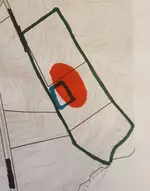
The most interesting thing I found was this complete brass cuff link. The home site is in the woods but previously was farmed for many years; I have no idea how this survived and remained intact. It is a "bird cage" design, with two pieces soldered/brazed together. I don't know if this is from the 1700s or 1800s; I've never seen one like it.
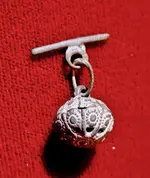
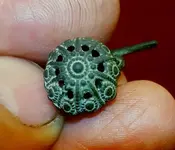
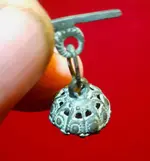
Another first for me was this brass heel plate
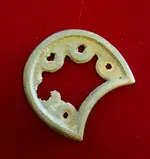
The horse-related relics were this saddle shield and several harness buckles
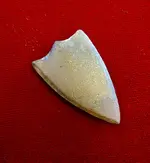
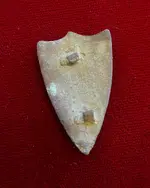
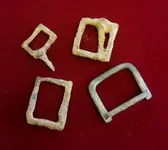
I really like this pocket watch winder; it still has a fair amount of gilt on it
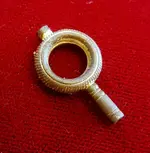
I managed to find several flat buttons, some with back marks and some without. My favorites are these two "A. Benedict" buttons with heavy gilt on the back sides. Aaron Benedict produced buttons as a sole proprietor from 1823-1829, then as Benedict & Coe from 1829-1934 and Benedict & Burnham until 1849. This eventually became the Waterbury Button Company.
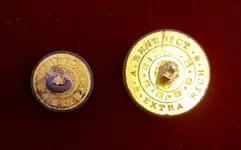
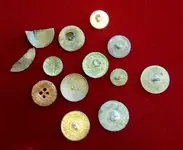
Iron finds included an 18th century hoe, part of a saw blade, the top of a large skeleton key and two "mystery finds."
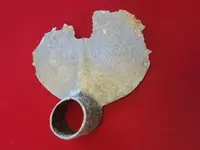
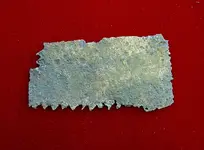
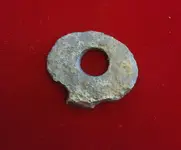
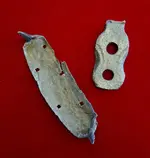
The rest of the finds from the site were a piece of an ornate shoe buckle and what might be a silver-plated ring (not really sure about this one)
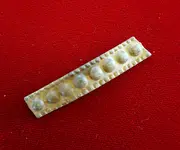
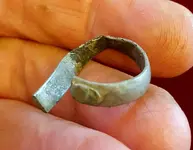
Well it was very rewarding to not only pin down the plantation house before I set foot on the property, but also to have the full provenance of the site and who lived there. In the immortal words Hannibal Smith of the A Team, "I love it when a plan comes together."
Several weeks ago one of my digging buddies obtained a permission at an old plantation site. In preparation for the trip I pulled up Mills Atlas of 1825; the plantation house was not on the atlas but just down the road the home of another person was marked. So I hit the Google trail and found the history of that plantation, which was started in the 1750s and was active until the Civil War. The document also contained a detailed map of the 2,600 acre plantation and (most importantly) had the plantation house (two houses actually) drawn in. It was close to a creek and right next to a main road, the remnants of which still exist.
So I overlaid the map in Google Earth and marked the location of the houses. Next I pulled up the current plats and owner info from the county GIS web site and marked where I thought the site was. A knock on the door of one homeowner got me permission to hunt there. Check. As it turns out the resident of the house on the second lot went to school with my cousin; permission #2 granted. The lot below it was family property so he also let me detect there. Check.
Before we started our search I marked on the plat map where I thought the houses were; see the orange oval mark in the picture below. So Iron Man and I set out to locate the plantation houses (he is a newbie and mostly only finds iron so I gave him a nickname lol). It didn't take long before I found a concentration of nails and started digging relics (later that day I also located the second house very close to the first one). Here is the plat map I marked prior to our excursion; the box I drew is the location of the houses.

The most interesting thing I found was this complete brass cuff link. The home site is in the woods but previously was farmed for many years; I have no idea how this survived and remained intact. It is a "bird cage" design, with two pieces soldered/brazed together. I don't know if this is from the 1700s or 1800s; I've never seen one like it.



Another first for me was this brass heel plate

The horse-related relics were this saddle shield and several harness buckles



I really like this pocket watch winder; it still has a fair amount of gilt on it

I managed to find several flat buttons, some with back marks and some without. My favorites are these two "A. Benedict" buttons with heavy gilt on the back sides. Aaron Benedict produced buttons as a sole proprietor from 1823-1829, then as Benedict & Coe from 1829-1934 and Benedict & Burnham until 1849. This eventually became the Waterbury Button Company.


Iron finds included an 18th century hoe, part of a saw blade, the top of a large skeleton key and two "mystery finds."




The rest of the finds from the site were a piece of an ornate shoe buckle and what might be a silver-plated ring (not really sure about this one)


Well it was very rewarding to not only pin down the plantation house before I set foot on the property, but also to have the full provenance of the site and who lived there. In the immortal words Hannibal Smith of the A Team, "I love it when a plan comes together."
Amazon Forum Fav 👍
Last edited:
Upvote
17





